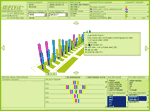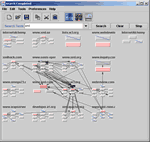Melvil 2.0
 Melvil
2.0 is a knowledge retrieval system that permits to represent the
collective knowledge of an organization. Thus it makes the whole organization's
information accessible to every single employee. Results are dynamically
displayed in a web-based 3D-environment and enable users to navigate
visually through meta and detail information spaces. Retrieving and
analyzing information becomes a visual and therefore more intuitive
task. Melvil
2.0 is a knowledge retrieval system that permits to represent the
collective knowledge of an organization. Thus it makes the whole organization's
information accessible to every single employee. Results are dynamically
displayed in a web-based 3D-environment and enable users to navigate
visually through meta and detail information spaces. Retrieving and
analyzing information becomes a visual and therefore more intuitive
task.
Melvil 2.0 is a system by UMA Information Technology AG, Vienna, Austria.
http://www.melvil.net
VisIT
 VisIT
is a search engine interface that, instead of lengthy lists, displays
results in an interactive, graphical, and analytical way. The retrieved
information is not shown as hits per page, but in a "search
space". The web pages are represented by icons that are grouped
around the respective web site; each web site is provided with its
URL, which allows to quickly scan hundred of hits at once. The result
is hierarchically organized; important web pages are located in
the center of the organigram and are additionally categorized through
the use of different shades of colors. Arrows visualize hyperlinks
and show which of the pages are regarded as relevant and useful
by other users. VisIT
is a search engine interface that, instead of lengthy lists, displays
results in an interactive, graphical, and analytical way. The retrieved
information is not shown as hits per page, but in a "search
space". The web pages are represented by icons that are grouped
around the respective web site; each web site is provided with its
URL, which allows to quickly scan hundred of hits at once. The result
is hierarchically organized; important web pages are located in
the center of the organigram and are additionally categorized through
the use of different shades of colors. Arrows visualize hyperlinks
and show which of the pages are regarded as relevant and useful
by other users.
VisIT is being developed at the Beckman Institute of Advanced Science
and Technology at the University of Illinois, Urbana-Champaign,
US.
http://www.visit.uiuc.edu
WebMap
WebMap's information mapping technology combines traditional
navigation, browsing and searching into one single visual interaction.
It provides a visual guide to information embedded in web sites,
intranets and extranets. In addition, by representing links visually,
WebMap saves screen space, which makes possible its use on small-screened
wireless devices also. Moreover, every WebMap function has the ability
to be touch driven, thus permitting its utilization on non-keyboard
platforms.
WebMap is a product of WebMapTechnologies Inc., Boston, US.
http://www.webmap.com
|

